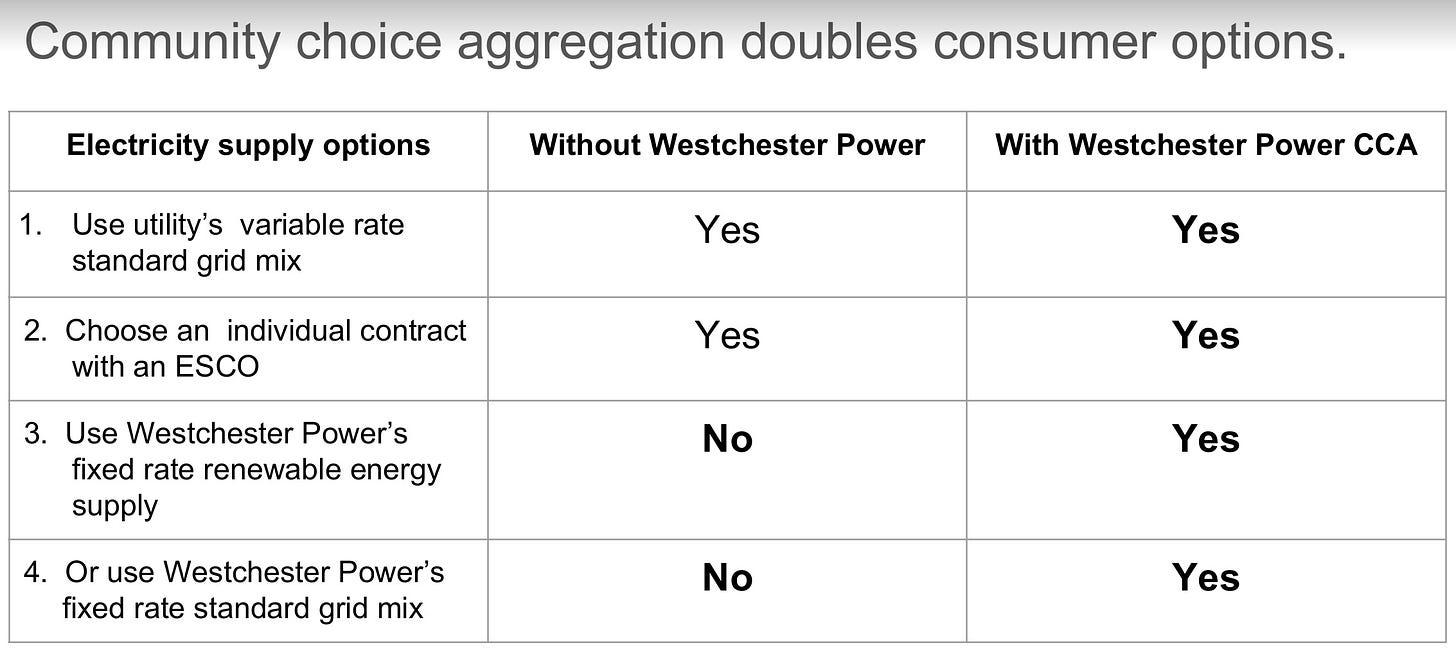Guest Editorial: Croton-on-Hudson chooses Community Choice Aggregation. Lowering emissions is the goal.
Croton's former mayor, now an official with Sustainable Westchester, argues that CCA is the best overall choice for the village and the planet.
by Leo Wiegman, Sustainable Westchester
Editor’s note: The Chronicle has covered the debate over which electricity supplier Crotonites should choose in a few recent articles, including a Guest Editorial by former trustee Bob Anderson. In this opinion piece, former Croton mayor Leo Wiegman gives an alternative view.
As we electrify our lawn mowers and bikes and cars, we should keep in mind the urgent need to green the grid as well.
Unfortunately, the ConEdison grid that serves our community uses combustion of gas, oil and other fuels for 93% of the energy production with only 6% from zero emission sources such as hydropower and solar.

Replacing an old oil or gas boiler with new heat pumps to make a home more comfortable year round does get rid of your direct purchase of gas or oil – it’s a good and important thing to do. But to reach our shared net zero emission goals, individual actions of this kind must be paired with systemic changes in our energy supply.
Before Community Choice Aggregation arrived in New York State, consumers who wanted an alternative to the default fossil fuel electricity supply mix had only one other choice: Dip into the energy service company [ESCO] marketplace for suppliers offering a clean energy sourced alternative.
My family did that for fifteen years before Croton joined Westchester Power. We paid a premium to support renewable energy in order to create a fledgling marketplace for clean energy. We had to rely on the marketing pitch from a “green” ESCO, not really knowing much about the actual product or whether a different ESCO might have a better offering. Although our experience was, on balance, positive, many others have found the private ESCO market difficult to navigate, with hidden fees, escalators and cancellation penalties posing real challenges for consumers.
Enter Sustainable Westchester in 2016 with the Westchester Power (WP) program that pooled the purchasing power of tens of thousands of households, giving all of us far more leverage in the energy marketplace than an individual consumer. The Public Service Commission authorized this first-in-New-York-State community choice aggregation in 2015 and it took about a year to set up. The goal was to secure the lowest long term fixed rate renewable energy supply rate with no hidden fees or escalators.
Of the over 70 ESCOS authorized to operate in New York State at the time, the Sustainable Westchester staff purged the list of eligible bidders down to a dozen reputable firms. These firms had to be large enough to handle a contract for the size of the energy block over the duration of the contracts. In addition, they had to meet the consumer protection requirement imposed by the program. The inaugural auction for eligible bidders took place in May 2016 for the twenty cities, towns and villages that had chosen to participate..
Meanwhile the Sustainable Westchester staff had been explaining community choice aggregation to municipalities in every corner of Westchester County. The auction would seek electric rates for two products on a 24 month fixed rate basis: One would be the standard grid mix (90% fossil fuel) and the other would be green (100% renewable energy credits).
In order to comply with the bid requirements, the standard grid mix rate offered by the ESCO would have to be at or below the 12 month trailing average from the default utility rate.
In a moment of fantastic market timing, the winning bidders for both the ConEdison and NYSEG municipalities took advantage of a glut of available wind energy credits to source the green supply at unexpectedly low rates. As a result, both the fixed rate, long term bids for the standard grid mix as well as the renewable energy offering were below the 12 month trailing average of both utilities’ rates.
All but two of the then twenty participating municipalities opted to use the 100% renewable energy rate as the new default for their residential and small commercial customers and locked in savings while going green. Since then, nine more municipalities have joined Westchester Power, representing about two-thirds of the county’s population.
In essence, consumers in a Westchester Power municipality now have 4 choices for their energy supply: (1) they may opt-out to remain with the local utility supply; (2) they may choose their own ESCO supply; (3) they may stay with the Westchester Power offering chosen as the default by their municipality; or (4) they may stay in the Westchester Power program and switch from the default offering for their municipality to the other offering, e.g. moving from the green offering down to the standard grid mix or vice versa.

It is true that the current Westchester Power contract has a higher price point than the utility’s variable rate. After all, energy markets are highly volatile and subject to many external factors, such as the disruptions in the global market for natural gas brought on by Russia’s invasion of Ukraine. But the fundamental benefits of Westchester Power transcend shifting market conditions: (1) clean, renewable energy, (2) expanded consumer choice, and (3) predictable, capped costs. By these standards, the program has been and remains a remarkable success, doing more to reduce regional greenhouse gas emissions than all other municipal actions combined.
If you want to do something to help mitigate future heat waves, tropical storms, and asthma rates from particulate matter pollution, join tens of thousands of other Westchester households in subscribing to the Westchester Power renewable energy supply. This aggregation is still the single largest household clean energy buy in New York State, supporting wind farms as well as legacy hydro power plants throughout the state.
We can all be proud of being part of the solution.
Former Croton mayor Leo Wiegman is now Director of Solar Programs for Sustainable Westchester and President of CURE100.org
To share this post, or to share The Croton Chronicle, please click on these links.
Comments policy: Please be polite and respectful, no personal attacks on any individual.




